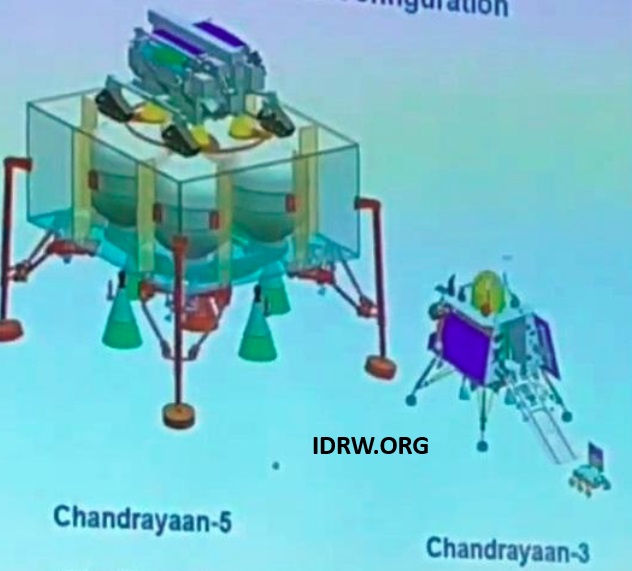SOURCE: AFI


India’s Chandrayaan program, which recently celebrated the successful landing of Chandrayaan-3, is poised to make a giant leap with Chandrayaan-5, also known as LUPEX (Lunar Polar Exploration Mission). This mission, a collaboration between the Indian Space Research Organisation (ISRO) and the Japan Aerospace Exploration Agency (JAXA), promises significant advancements in lunar exploration capabilities. Chandrayaan-5 is set to carry a considerably larger rover with enhanced scientific capabilities, aimed at furthering our understanding of the Moon and paving the way for future human exploration.
One of the most striking differences between Chandrayaan-3 and Chandrayaan-5 lies in the size and capabilities of the landers and rovers:
- Chandrayaan-3 Rover: Chandrayaan-3 carried a 25 kg Pragyan rover, which achieved several critical milestones in lunar exploration, including navigating the surface and conducting elemental analysis.
- Chandrayaan-5 Rover: The upcoming mission will deploy a much larger, 350 kg rover. This significant increase in size is driven by the mission’s objectives, which include in-depth surface analysis, extended operational duration, and the potential for sample-return technology demonstrations.
This increase in rover size allows Chandrayaan-5 to carry more sophisticated scientific instruments and perform a wider range of experiments, crucial for long-duration lunar operations and gathering comprehensive data on the lunar polar regions.
The Chandrayaan-5 mission, building on the successes and lessons from previous Chandrayaan missions, will focus on the Moon’s south pole, a region of intense scientific interest due to its potential water ice deposits and unique geological features. This mission aims to develop capabilities that could be foundational for a future human landing on the Moon.
1. High-Capacity Lander Development and Mission Operations
- Enhanced Payload Capacity: Chandrayaan-5’s lander will be larger and more robust, accommodating a heavier rover with more complex scientific instruments. This improved lander will increase the payload capacity significantly, a necessity for supporting the mission’s extended objectives and larger equipment.
- Collaborative Operations: By working with JAXA, ISRO benefits from Japanese expertise in precise landing and navigation technology, enhancing mission reliability and safety.
2. Demonstrating Critical Technologies for Future Human Exploration
- Precision Landing: Chandrayaan-5 will showcase advanced landing technologies that are crucial for pinpoint accuracy, particularly vital for future human missions that require safe and predictable landing zones.
- Extended Lunar Surface Duration: Chandrayaan-5 aims for prolonged operations on the Moon’s surface, made possible by energy-efficient systems and improved thermal management. This capability will allow for more extensive research, including potential night-time operations in lunar polar regions.
- In-situ Lunar Sample Analysis: A key advancement in Chandrayaan-5 is the ability to conduct in-situ analysis of lunar samples directly on the Moon’s surface. The mission will be equipped with scientific instruments capable of analyzing the composition and mineralogy of lunar soil, adding depth to our understanding of lunar resources and geology.
3. Increased Rover Payload and Scientific Capabilities
The 350 kg rover represents a substantial leap in ISRO’s technological capabilities, designed to support a suite of advanced instruments for data collection. The larger rover will be capable of traversing longer distances, conducting a variety of experiments, and potentially transmitting data over extended periods, significantly enhancing India’s contributions to lunar science.
Chandrayaan-3 marked a pivotal success for ISRO, establishing India’s capability in soft lunar landings. Chandrayaan-5 will build on this foundation, with advancements designed to propel India’s lunar exploration to new heights. The mission’s emphasis on in-situ analysis and long-duration operations will not only yield valuable scientific data but also lay the groundwork for potential human exploration on the Moon.
The transition from Chandrayaan-3’s 25 kg rover to Chandrayaan-5’s 350 kg counterpart symbolizes ISRO’s growth and ambition in space exploration. With a mission profile that targets the Moon’s polar regions, Chandrayaan-5 is set to provide insights that could reshape our understanding of lunar geology, resources, and potential habitability. This mission underscores India’s commitment to contributing meaningfully to humanity’s collective knowledge about space, while also enhancing its own technological capabilities for future interplanetary missions.